Family : Geometridae

Text © Prof. Santi Longo

English translation by Mario Beltramini
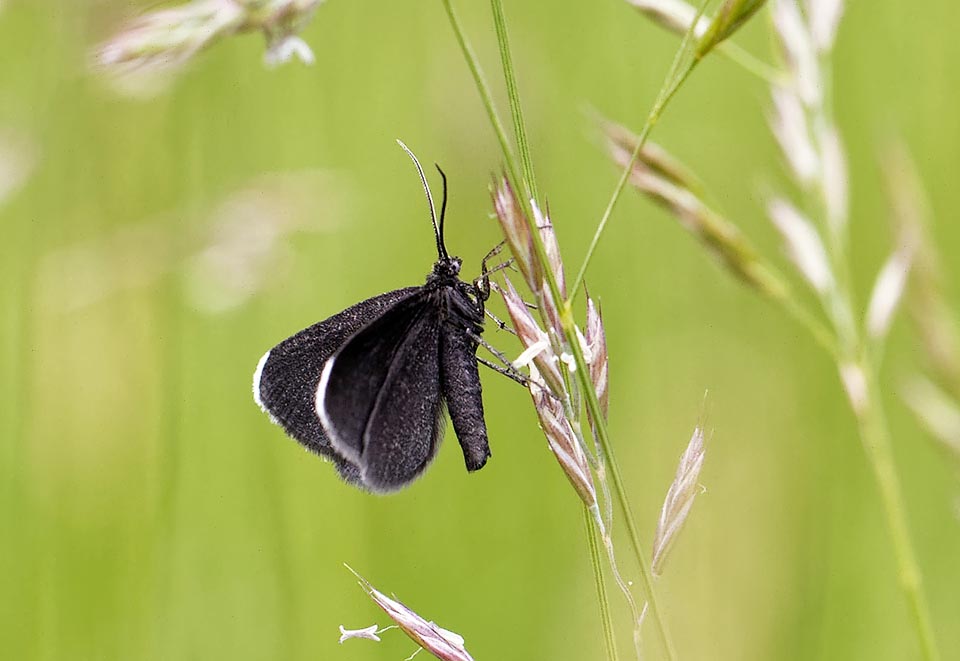
Of Palearctic origin and now rare in various locations, the Chimney sweeper (Odezia atrata) is present in all Europe, in the Balkans and in Mongolia © bellemma
Odezia atrata (Linnaeus, 1758) is a Geometridae commonly known as Chimney sweeper due to the dark brown colour of the adults to which refers the specific epithet atrata, blackened in Latin.
Rightly known in English as “Chimney sweeper”, in German is known as “Rouwspanner” or “Kaminfegerle” and in Swedish “Sotmatare”.
Described by Linnaeus in 1758 as Phalaera atrata the species has been transferred to the monospecific genus Odezia by Boisduval, who created it in 1840 honouring it to a lady of his family.
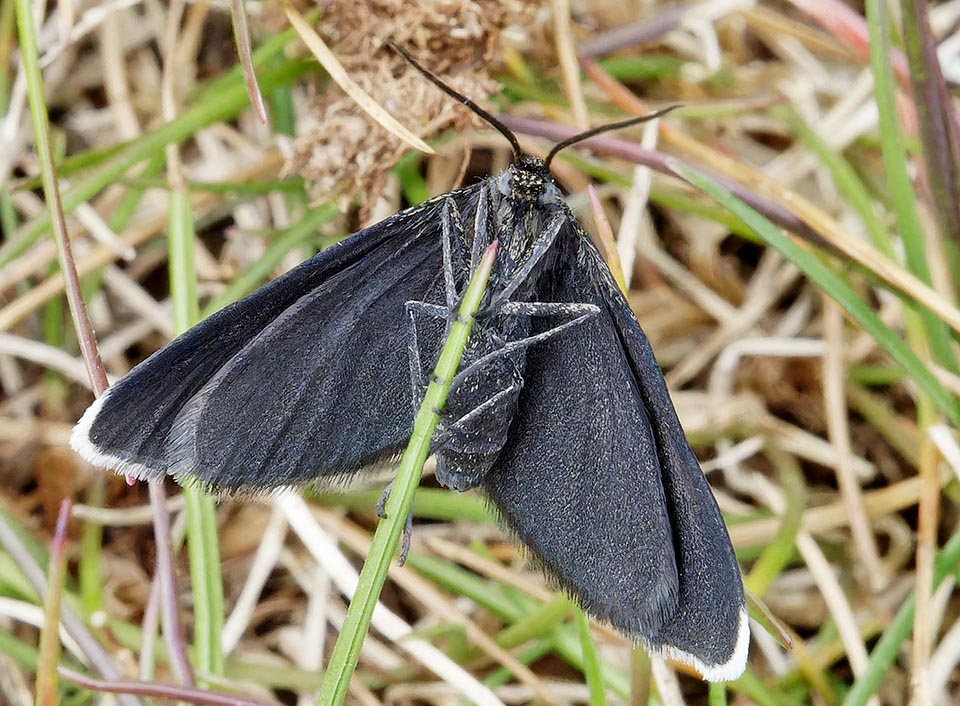
Here seen ventrally. As the common name states the wings are blackish, but the fore ones, with the extreme margin and the apical fringe of apical hairs © Ian M. White
Zoogeography
The species, of Palearctic origin, once was very common, nowadays it is rare in several locations and it is thought that its populations have disappeared from many zones.
The Chimney sweeper is diffused all over Europe, where it is reported in the Iberian Peninsula, in the central Finnish Scandinavian peninsula, in Italy and in the British isles. It is also present in the Balkans and in Mongolia.
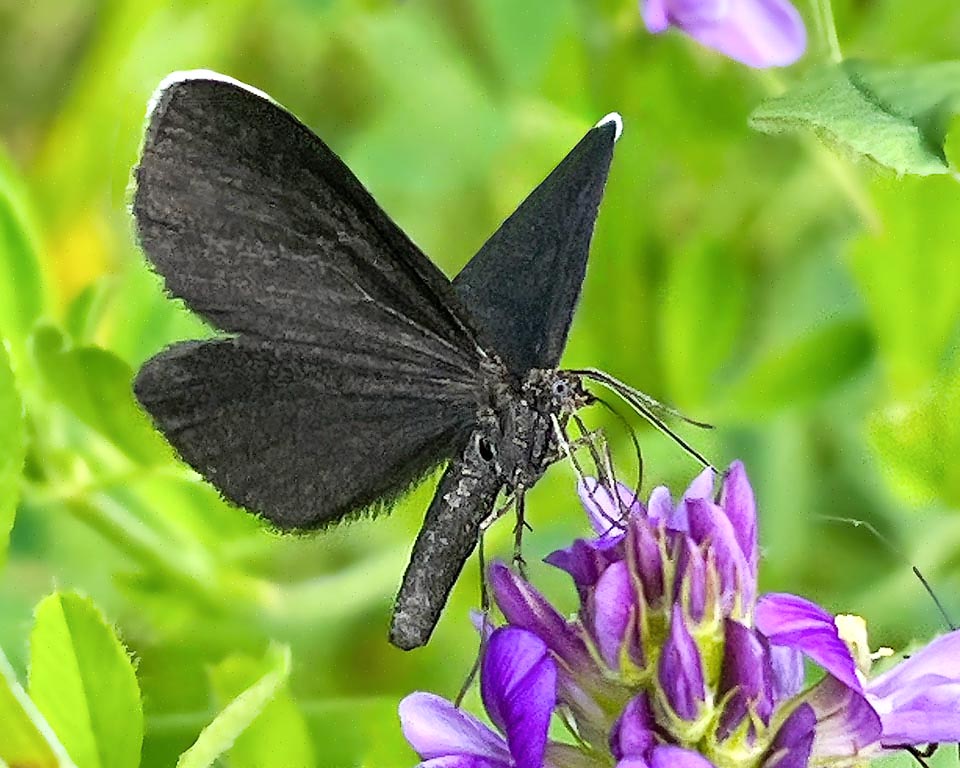
Frequent in fields, Odezia atrata nourishes with its spirotromba of nectar, honeydews or of ripe fruits juices. The wingspan is of 24-30mm © raeubertochter
Ecology-Habitat
Odezia atrata lives in the European zones with temperate and cool climate, where is present at the borders of forests and woods, in the moderately wet meadows, along the banks of ponds, as well as in the agricultural zones and in the urban and suburban areas, where do grow the Apiaceae hosts of the genera Conopodium, Anthriscus and Angelica. The larvae, nourishing of the leaves, often cause defoliations.
Morphophysiology
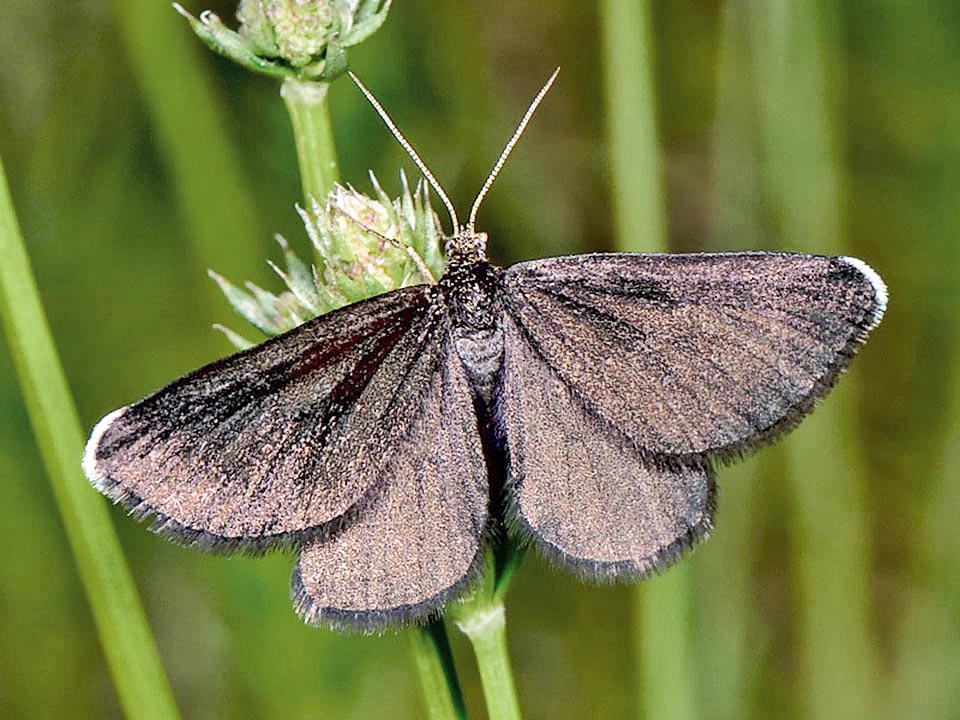
Over time, few days after fluttering, the livery tends to dark brown with the exception of the white apical margins © Paolo Mazzei
The adults, of dark brown colour, have a wingspan of 24-30 mm. The forewings measure 12-15 mm, almost wholly black, with white haired extreme margin and apical fringe.
A few days after flickering, the livery gets dark brown with the exception of the apical margins.
Paul Thierry-Mieg has described as Odezia atrata nigerrima a female without white margin and white apical fringe.
The eggs are oval shaped and are of pale colour that gets progressively darker as the embryo and the larva form.
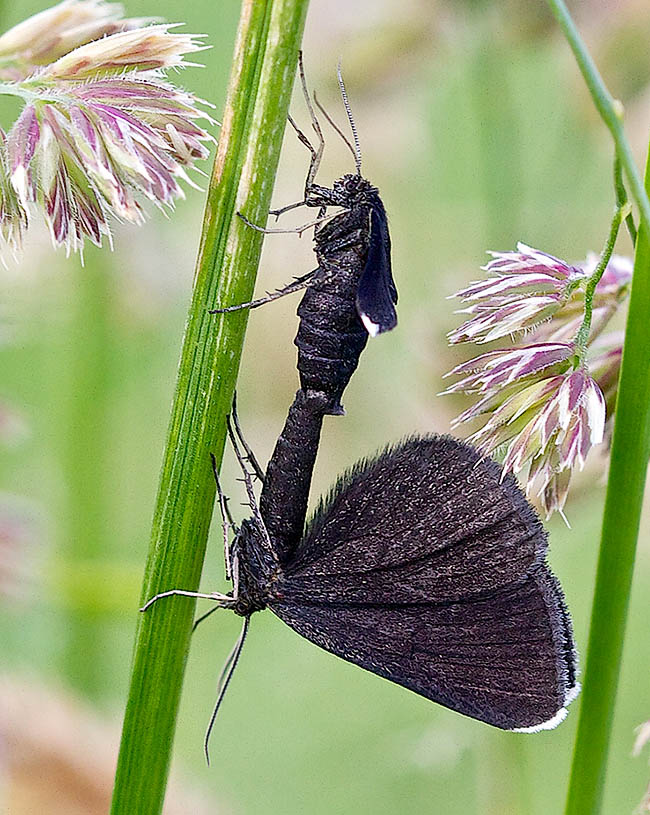
A mating. Adults are active from May to August, especially during the brightest hours of the day. Females lay on the lower pagina of the leaves of Apiaceae of genera Conopodium, Anthriscus and Angelica © Gediminas Gražulevičius
The five larval stages have the body of colour varying from yellow to green with darker dorsal stripes; they are oligopod, as they have 3 pairs of thoracic legs and only 2 of abdominal pseudo legs placed at the sixth and tenth urite.
Because of this morphological characteristic, common in all Geometridae, they move in a characteristic way, arching and stretching the body like a compass, giving the sensation of measuring the ground like the geometers.
The mature larvae reach the soil or the cracks in the barks, where they chrysalise.
The chrysalis is more or less dark brown in colour.
Ethology-Reproductive Biology
The adults are active from May to August, especially during the brightest hours of the day, fly along the edges of ditches and of lakes, in the meadows and in the moors feeding on nectar, honeydews or ripe fruit juices.
During the night hours they are attracted by the lights.
The males, as soon as they flutter, go looking for the females following the trails of the sexual pheromones they have freed and, in relation to their short lifespan, that ends after mating, often do not feed themselves.
In July, the females lay groups of eggs on the lower pagina of the leaves of the host plants where they spend the whole winter.
In spring the eruciform larvae are born, they initially eat the chorion of their eggs and then start to gnaw at the tender leaves of the host Apiaceae.
The various larval stages, in order to escape the birds, the reptiles, the Mantises and other predators, camouflage themselves keeping motionless on the twigs of the host plants and taking on the colour and at times even the shape of their support; in this way they disappear from the predator’s sight as the outlines of their body dissolve and blend in with the plant.
Such cryptic and behavioural mimicry proves to be effective only towards predators who visually identify the larvae but not against some species of Scelionid Hymenopterans of the genus Telenomus Haliday, 1833.
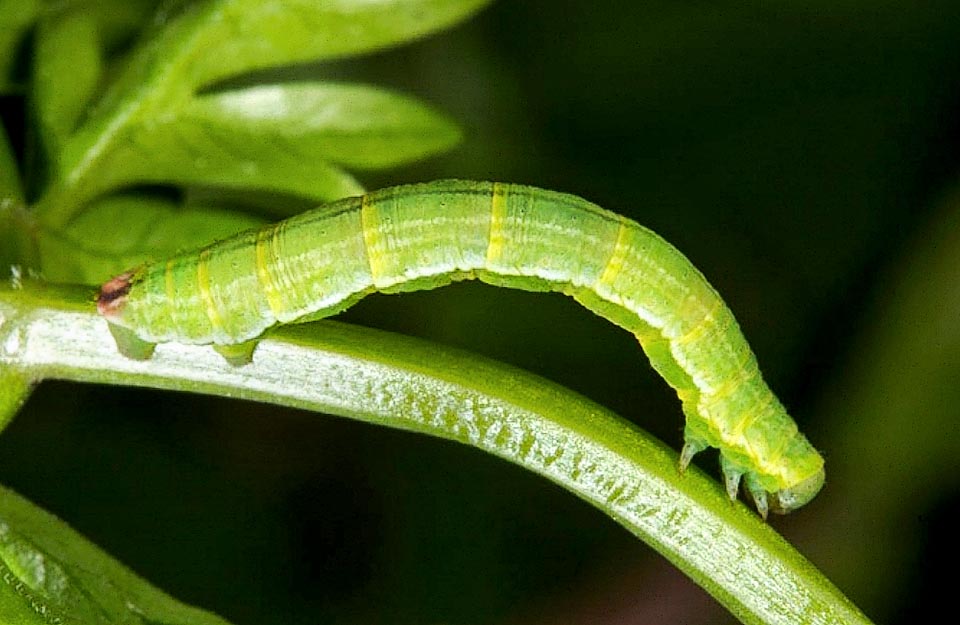
The caterpillars move like a compass, with the typical movement of the Geometridae family © Wolfgang Wagner
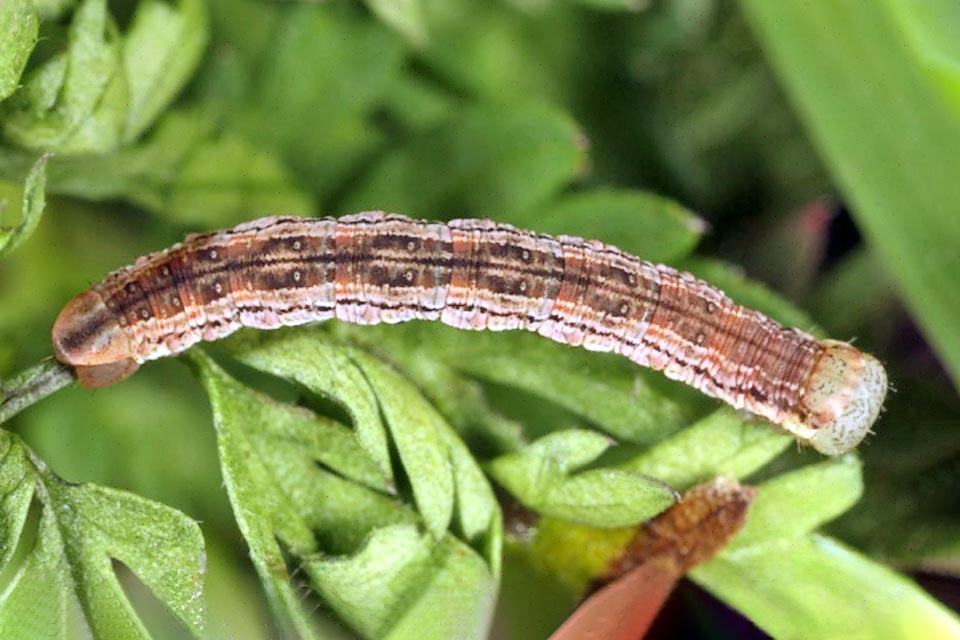
They take the colour and at times also the shape of the support, stiffening still in case of danger to escape the sight of the predators © Wolfgang Wagner
These in fact inject their eggs into the body of the poor larvae, after having reached, guided by the smell, the host plant. They easily find them following the sounds, the vibrations emitted and especially the volatile compounds, defined as kairomones, present in their salivary secretions and their excrements.
The chrysalises that take refuge in the cracks of the tree’s barks or under the leaves in the soil are finally preyed upon by Carabidae Coleoptera.
However, the rarefaction of the Geometrid depends mostly on the alteration and on the degradation of the habitats where the host plants live.
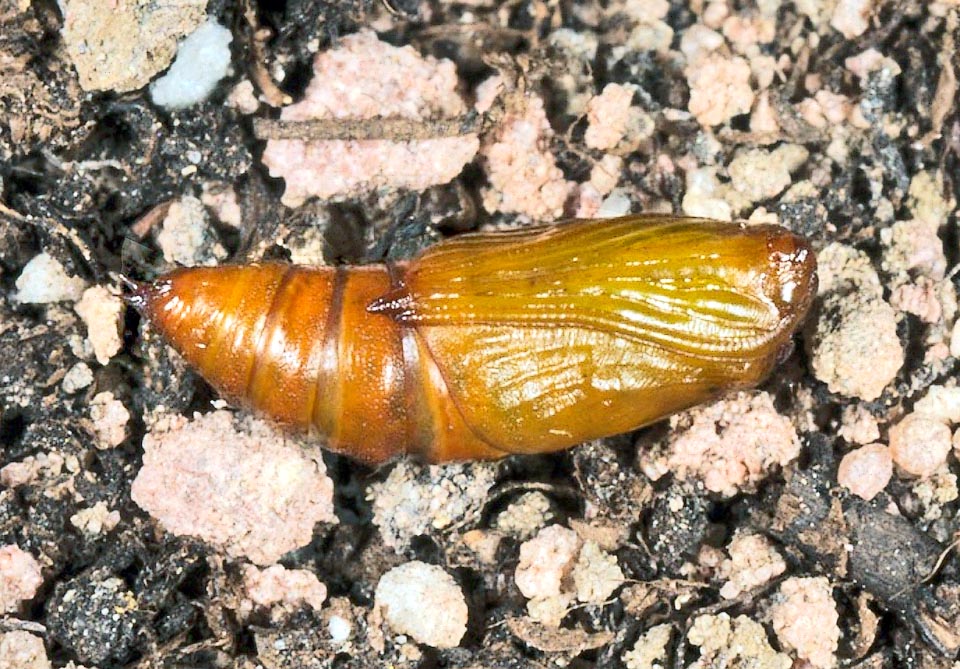
The chrysalises stand hidden into the cracks of the barks or on the ground under the leaves © Wolfgang Wagner
Synonyms
Baptria chaerophylla (Hubner,1825) Odezia cherophyllaria (Hubner,1825); Odezia chaerophyllata (Linnaeus 1761); Odezia dalmatina Staudinger, 1920; Odezia denigrata Prout, 1934; Odezia nigerrima Thierry-Mieg,1910; Odezia perfusa, 1927; Phalaena atrata Linneo,1758; Phalaena chaerophyllata Linneo,1767; Tanagra atrata, (Linnaeus,1758).
Subspecies: Odezia aatrata atrata (Linnaeus, 1758); Odezia aatrata haraldi (Fibiger, 1997); Odezia atrata meridionalis Reisser, 1935; Odezia atrata pirenaica Gumppenberg, 1887.
→ For general notions about the Lepidoptera please click here.
→ To appreciate the biodiversity within the BUTTERFLIES please click here.
